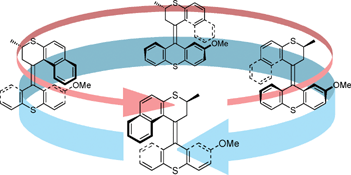Exploring the boundaries of a light-driven molecular motor design: new sterically overcrowded alkenes with preferred direction of rotation†
Abstract
Insight in the steric and electronic parameters governing isomerization processes in artificial molecular motors is essential in order to design more advanced motor systems. A subtle balance of steric parameters and the combination of helical and central chirality are key features of light-driven unidirectional rotary molecular motors constructed so far. In an approach to decrease the steric hindrance around the central olefinic bond (rotary axis) and thereby lowering the energy barrier for helix inversion resulting in an increased rotation rate, the boundaries of our molecular motor design are explored. In a new design of a light-driven molecular motor based on a sterically overcrowded


 Please wait while we load your content...
Please wait while we load your content...